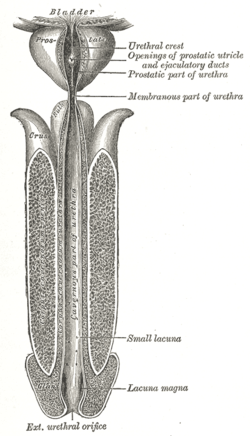Vesicula prostatica
| Prostatic utricle | |
|---|---|

Vesiculae seminales and ampullæ of ductus deferentes, seen from the front.
|
|

The male urethra laid open on its anterior (upper) surface.
|
|
| Details | |
| Precursor | Müllerian duct |
| Identifiers | |
| Latin | Utriculus prostaticus, utriculus masculinus, vagina masculina, sinus pocularis |
| TA | A09.4.02.009 |
| FMA | 19702 |
|
Anatomical terminology
[]
|
|
The prostatic utricle (Latin for "pouch of the prostate") is a small indentation in the prostatic urethra, at the apex of the urethral crest, on the seminal colliculus (verumontanum), laterally flanked by openings of the ejaculatory ducts. It is also known as the vagina masculina or (in older literature) vesicula prostatica.
It is often described as "blind", meaning that it is a duct that does not lead to any other structures.
It can sometimes be enlarged.
The prostatic utricle is important, primarily, because it is the homologue of the uterus and vagina, usually described as derived from the paramesonephric duct, although this is occasionally disputed.
In 1905 Robert William Taylor stated the function of the utricle, writing, "In coitus it so contracts that it draws upon the openings of the ejaculatory ducts, and thus renders them so patulous that the semen readily passes through."
...
Wikipedia
